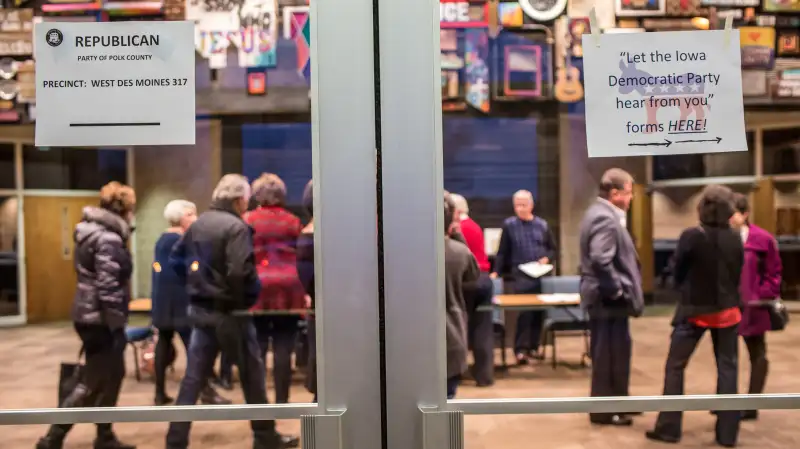This Really Is the Most Economically Unrealistic Presidential Race of All Time

As the presidential race started in earnest last year, I signed on to write for Money about the pocketbook impact of the economic proposals bandied around in the presidential race. It sounded straightforward: Take all the complicated economics and accounting, and boil them down to explain the impact of the policies we’re choosing between.
We're now one state into the primary season. The citizens of Iowa have weighed, measured, understood the candidates' position, and chosen those who have made the most compelling case for their well-thought out policies.
As if.
Here's the reality: Of the top three Republican vote getters—Ted Cruz, Donald Trump, and Marco Rubio—not one has a budget plan that would leave less than a multi-trillion-dollar hole in the budget. More or less the same goes for Vermont senator Bernie Sanders, though he would dig that hole by raising expenses instead of cutting revenue. Only Hillary Clinton does a little better, largely by avoiding getting pinned down on specific promises.
Writing about policy in this election hasn’t turned out to be straightforward at all. Never in memory has there been a campaign in which it has been so hard. Why? Because figuring out real policy effects this election season is like trying to tell you how many calories you’ll get in each serving of pie-in-the-sky. You think about it and wonder, “Is this roughly equivalent to apple pie? Or to blueberry?” and then, “Wait a second, do people know you can’t really eat this?”
That sounds extreme. So let’s get specific. Back in the 2000 presidential race, George W. Bush proposed a package of tax reductions that would cut $1.3 trillion from federal revenues over nine years. This was considered an aggressive tax cut, and brought about legitimate debate over whether the country could afford it, and how much of the cut would go to the rich. Bush won, and indeed went ahead with the headline parts of the plan, cutting tax rates across the board.
Sixteen years ago, $1.3 billion over nine years sounded like a lot—and we were in a period of federal surplus. It is nothing compared to the costs of the proposals thrown around now. The liberal-leaning Tax Policy Center estimates the costs of Donald Trump’s proposed tax cuts (led by a cut to 25% in corporate tax rates and top individual rates) at $9.5 trillion over a decade. The conservative Tax Foundation sets the price at $12 trillion, though it sees a couple of trillion in economic stimulus coming from that.
Marco Rubio’s tax plan, with its investor friendly zero percent capital gains tax? That’ll cost $414 billion a year in revenue—more than $4 trillion a decade—by the Tax Foundation’s calculations. Over the long term, supply siders like to think that cutting taxes will spur economic growth. The Rubio plan would be an unprecedented bet in that direction, making the Bush and Reagan tax cuts look piddling by comparison. Meanwhile, Ted Cruz suggests dumping the whole tax system for individual and business flat taxes at similar cost. And you’ll be able to fill that out on a postcard.
I hope you don’t mind losing your home mortgage interest deduction—because there’s no space on the postcard for that.
Lest you get the idea that this is merely a Republican phenomenon, go ahead and look at Bernie Sanders’ health plan. It’s very attractive ... as long as you’re okay with “We’ll get there somehow” as a plan for cutting $600 billion a year in health care costs. Much the same goes for Sanders’ plan to make tuition free for all at public colleges. Where will the money for that come from, again?
Clinton's education plan is also vague on payments. Its defense is that if you're looking for money in the couch cushions, it's probably easier to find $35 billion a year—if you're counting, that's close to a quarter of the George W. tax cut—than $400 billion.
But haven’t politicians have always pandered to voters with proposals that were never going to translate into real policy?
Well, no. Not like this. Obviously, candidates have always taken an optimistic view of how much they can cut in taxes and gain in savings. But it’s really over the past few election cycles that proposals from major party candidates have become this divorced from economic reality.
Let’s go back to the videotape. In 2008, John Edwards, like Bernie Sanders, ran to the left of the eventual winner (Barack Obama) with an aggressive education plan. It called for taking the banks out of college lending (that actually became federal policy) and a free year of tuition. So, roughly, we’ve gone from one year of free tuition and taken it to four.
“Just multiply everything by about four (or maybe eight),” nicely frames the pattern across the political landscape. It took a while to get to this point. Consider former Massachusetts governor Mitt Romney in the 2008 campaign. In January 2008, ahead of the Iowa caucus, Romney proposed a plan of tax cuts and economic incentives that carried a price tag of $250 billion (that’s total, not per year) and included what now sound like fairly modest measures like cutting the lowest tax rate from 10% to 7.5%. Romney, you will recall, lost to Arizona senator John McCain. McCain proposed a set of cuts that would cost about $600 billion over a decade.
What lesson did Romney take from this? Apparently it was something along the lines of “Go bigger.” So in 2012 Romney proposed a plan that would lop about 20% off all tax rates, reducing government revenue by $480 billion a year, according to the Tax Policy Center. The plan was slammed from all sides. Josh Barro, an influential Republican-leaning columnist, said it was “plucked out of thin air for political reasons without regard to whether it was feasible.”
Now let’s get back to the 2016 cycle. Revenue cuts in the $400 billion a year range are par for the course among the conventional candidates, while Trump’s plan grazes the edges of a trillion bucks a year. The new wrinkle in this cycle is that four years ago Romney felt the need to justify his plan, however ineffectively, as “revenue neutral,” promising that by cutting deductions and expanding the economy we’d come out with a budget that wouldn’t add to the federal deficit. Romney and his advisers worked to come up with studies that would justify that.
Trump, too, says that he won’t increase the deficit. He doesn’t need a pointy headed study to show you how, because “the economy will take off like a rocket ship.” Cruz really doesn’t worry so much about how to make up the money, because he wants to cut government anyway. Starting with eliminating the IRS. You know, the agency that collects the money.
As the primary season moves on to New Hampshire, I wish I could help voters there by untangling all these plans and telling them what might work and what won’t. Or get some experts to untangle it for them. Except it’s hard to believe that anyone really needs me to do that for them. Journalists, too, don’t really need a study to tell them the obvious: You can’t run a government by cutting $400 billion or a trillion dollars a year in taxes, summoning up $600 billion a year in health care from thin air, or cutting the tax code into a ten card stack of Mad Libs. More important: No one is actually going to do anything close to that after taking office.
Most voters know that intuitively. Candidates have asked them to ignore the details, and trust their gut. In Iowa, Ted Cruz delivered on his promise, Marco Rubio overperformed, and Hillary Clinton held on, barely. The well-informed take (i.e. the conventional wisdom) coming out of Iowa will probably be that realism triumphed among Republicans, and tied among Democrats. Really, though, it didn't.
Sure, Trump may be the least policy-driven candidate of all time. But it's a matter of degree. Most of the leading candidates now treat policy as a vaguely expressionistic canvas, asking voters to go with whichever painting feels most right to them, regardless of how unlikely it is to translate into real life. It makes for a tough job for policy writers, who mostly don't make great art critics. And for voters, too, who deserve something more nourishing to get them through the cold primary season in Iowa and New Hampshire.
